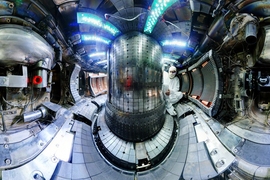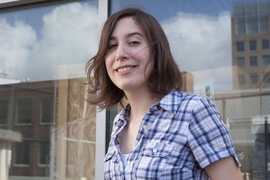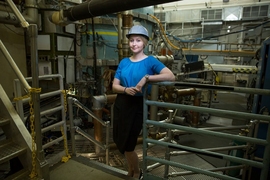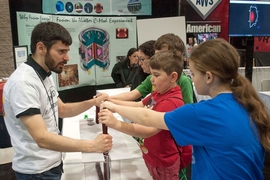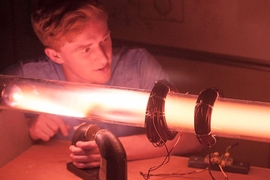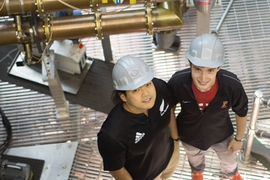Pablo Rodriguez Fernandez is hunched over a computer in the control room of MIT’s fusion reactor, gathering data that will inform the design of a new one — a device that could solve the world’s energy problems. He is surrounded by other scientists running simulations and analyzing data. Their work is spread across tables and desks covered in computers and a chaos of wires. The objective: to design a machine that will harness the same energy process that powers the sun and deliver it to the world, carbon free. They are here to make fusion energy a reality.
This is the headquarters of a MIT’s Alcator C-Mod. A fixture on campus for 23 years, C-Mod uses high-intensity magnetic fields to confine hot plasma in a donut-shaped chamber — a reactor design known as a tokamak, a transliteration of a Russian word for “toroidal chamber.” During C-Mod’s final run, the reactor’s team of operators will take MIT’s high pressure world record to an extraordinary new level. It will create renewed hope that a faster path to clean and safe energy is before us.
On this day in mid-September, as Fernandez and his fellow graduate students in the Department of Nuclear Science and Engineering type, calculate, and predict, the machine is operating on the other side of a nearby concrete wall. Fernandez, along with PhD candidates Alex Creely and Juan Ruiz Ruiz, have joined research scientist Nathan Howard to run a code that combines plasma measurements from several tokamaks, including C-Mod, into a single model. They have worked on other tokamaks, such as NSTX at the Princeton Plasma Physics Lab, ASDEX-Upgrade at the Max Planck Institute in Germany, and DIII-D at General Atomics in San Diego. All of them are world-class facilities, but C-Mod’s atmosphere is special, say Creely and Fernandez, who are in shorts and sneakers. “It’s less formal at MIT than at the national labs,” says Fernandez. His t-shirt reads, “Changing the World.”
Despite its apparently casual atmosphere, C-Mod has also established stringent safety standards that have been widely exported across the MIT campus. That balance between rigor and flexibility, says Creely, is part of what has made C-Mod such a success. “This is one of the most powerful machines in the world, and graduate students can go in and work, build diagnostics and such, on our own time,” he says. “People are open to you attaching new things and making modifications. It’s just this awesome university feel here,” he adds. He nods toward the scientists with legs draped over the backs of office chairs, the bike helmets, water bottles, Coke cans, and the student lab equipment decorated, in some instances, with beer logos and political slogans. “We have people from physics, aero-astro, nuclear engineering, wherever. All this expertise in one location. And you can just go talk to people.”
Indeed, even before its final experiment changed the debate over field intensity and materials, the world of fusion science owed a great debt to C-Mod. The machine has been at the heart of energy experiments that have shaped the careers of hundreds of scientists and engineers. It has inspired almost 200 doctoral theses, dynamic collaborations, and scientific breakthroughs. It has been the training ground for a whole generation of plasma scientists.
“We’re not just doing science.”
Anne White and her students are striking a campy, dramatic pose for a group photograph. They are in a hallway outside of the control room creating a commemorative record of their time together in the reactor complex on Albany Street. Hanging on the wall behind them are the protective hard hats that are required when entering C-Mod territory. Many of them are personalized with last names. These, too, are on the way to becoming mementoes.
White, the Ida and Cecil Green Professor in Nuclear Engineering, and her team of students are international leaders in assessing and refining the mathematical models used in fusion reactor design. With the closure of C-Mod, White says, she has arranged intensive collaborations with other groups worldwide. These relationships will be key for their research continuing and moving forward.
Later the same afternoon, she and John Rice, a senior research scientist, talk openly about the shutdown. Rice has been at MIT for 45 years. During that time, three Alcator machines have come and gone, but C-Mod will be the last in this line. “I’m probably one of the last people to accept the situation,” Rice says. “I still can’t believe next Friday is going to be the last day.”
The two of them are from different generations. White more formal in a tailored outfit with her blonde hair up in a bun, a pencil stuck through it. Rice with his long gray hair braided down his back in a look reminiscent of the 70s. MIT fusion scientists, they agree, will maintain a broad experimental portfolio and connections to friends around the world.
“We will keep having an impact on the science,” says White. “Students will get a chance to do awesome stuff and write lots of papers and go through the training we think is so important for fusion scientists.”
In 2012, the Department of Energy (DOE) announced the end of funding for the reactor. The White House had decided to invest instead in the International Thermonuclear Experimental Reactor (ITER), which is under construction in France, a project that draws directly from design and materials advances made in C-Mod. Although MIT’s fusion experiment was slated for elimination in both the 2013 and 2014 fiscal budgets, broad-based advocacy efforts managed to keep it alive until this month.
Government players are at odds when it comes to supporting fusion research. The White House wants to see a 9.2 percent reduction in the DOE’s $438 million Fusion Sciences Program in 2017. Senate appropriators would cut it even further to $280 million — but zero out contributions to ITER and redistribute the money to other energy programs. The House, meanwhile, wants to boost the program spending by 2.7 percent but contribute the bulk — $125 million — to ITER. It may be many months before lawmakers reach clarity on fusion research spending in the U.S.
Now, with the closure looming, Rice is trying to make the best of it. “We have data analysis left to do. We have plans for the future. We have great people who work well together — and we intend to continue to move fusion forward,” he says.
Listening from a few computer terminals away, team member Norman Cao, a graduate student in the nuclear department, adds: “Fusion is a cool place to be. We’re not just doing science. We’re trying to apply it to the real world.”
Fusion science rooted at MIT
In his office across the street, Martin Greenwald, deputy director of MIT's Plasma Science and Fusion Center, is working hard to get new projects off the ground. The closure of C-Mod is the end of a chapter but it’s not the end of the story, he says. “These machines have their own lifetime. They start, we do research, and they end. Our work will continue.”
Many of the most influential concepts in fusion science have been developed at MIT, says Greenwald. Recently, he came across a 1971 patent for the first of the Alcator machines. Then, as now, the project was focusing on a high-magnetic-field approach to fusion. Indeed the fusion program, born in the early 70s, is a direct result of the synergy between MIT physicists and engineers at the Francis Bitter Magnet Laboratory, which is part of the Plasma Science and Future Center. “Our magnet group invented an approach to superconducting magnets that is essentially the default today. It’s used by all the big machines in fusion,” says Greenwald. “Now we want to develop magnet technology further.”
There is good reason. Fusion reactions are slow until the fuel is heated to unimaginably high temperatures, “over 100 million degrees — far hotter than the core of the sun,” says Greenwald. Then electrons in the fuel atoms are stripped of their nuclei and the gas becomes a plasma, the fourth state of matter. At these temperatures, magnetic fields are the only reliable way to insulate hot plasma from material walls of the reactor. “We’ve attained the necessary plasma densities and temperatures in C-Mod,” says Greenwald. “But Alcator reactors are relatively small. They produce about as much fusion power as they consume.”
Figuring out how to yield net energy production out of a fusion reactor is really the heart of what researchers are pursuing now. The creation of a giant tokamak such as ITER is a massive endeavor. The international effort is projected to exceed $50 billion, which is 10 times the original estimate. Fueled experiments will not begin before 2027 — already more than a decade behind schedule.
There might be alternatives to “going big,” says Greenwald. He describes the MIT-student designed “Affordable, Robust, Compact” (ARC) reactor design proposal, which calls for a smaller, more modular reactor that relies on advances in materials and magnet technology. Such a tokamak could be built at one-tenth the size and cost. To begin, MIT will seek private funding.
The Advanced Diverter Experiment, or ADX, is a project MIT would like to develop in parallel. It would be roughly the same size as C-Mod but use a different design. It would tackle several important problems for fusion by enabling researchers to learn more about the behavior of hot plasmas, their interactions with material surfaces, and the behavior of structural materials in a fusion environment. MIT has proposed that the Department of Energy fund it.
Greenwald says the easy joke is that fusion energy is the power source of the future — and always will be. But he believes otherwise. “There is a lot of energy and excitement here about what we could do moving forward. We can hit a home run if we can just get up to bat.”
“Young people are driving the innovations.”
Ten years ago, Dennis Whyte came to MIT in large part because of its fusion program. More specifically, he came because he saw that students were combining their classroom learning with hands-on training at a world-class fusion facility. Today about a third of C-Mod’s experimental leaders are students, says Whyte, head of the Deaprtment of Nuclear Science and Engineering and director of the Plasma Science and Fusion Center. “Young people are driving the innovations. They are rethinking old assumptions and really making us think about new ways that we can get to fusion,” he says. “They are changing how research is done in the modern age.”
The relative youth of the faculty members in Whyte’s department supports his observation. Nine out of 17 are under the age of 40. “The drive that comes from this new generation of fusion scientists is immense,” Whyte says. “Just a few years ago, it did not seem as if we’d be able to make net energy possible.” With a new generation of superconducting materials and a design path blazed by Alcator C-Mod, which firmly established the advantage of using high magnetic fields to achieve fusion energy, “suddenly we have an opportunity to develop extremely compact and very efficient devices,” he says.
“This is what makes MIT great. We get these young people in here and we empower them to actually rethink standard assumptions and try to make the world better through their dedication and talent. And they do it.”
Breaking a record on the final day
Back in the control room, Earl Marmar glances toward several large display screens that entirely cover a front wall. They show him the tokamak is operating at full parameters. Head of the Alcator C-Mod project since 2002, Marmar is not holding the machine back. There was a time he was hesitant to run the reactor at its highest magnetic fields for fear of stressing it. Those days are over. “For the last few years, we’ve really pushed hard. We’ve learned new things as a result, and we haven’t broken the machine,” he says. “Even now we have new ideas coming. We’re still running for another week. It’s not over yet.”
He says the federal government provided funds to put C-Mod into a safe shutdown state. “It will be in a condition where we could bring it back up to life in the future. Although there is no plan to do that right now. We are heading in new directions.”
The lived-in feel of the control room speaks to the kind of familiarity the scientists, engineers, and students have developed with the machine, and with each other. Over by her team, Anne White speaks with Howard, who says graduate students have benefited greatly from the opportunity to work directly on a tokamak. “We’re doing these collaborations but there is just nothing like having your own machine. Losing it is a sad state of affairs. But we’ll take our skill set that we’ve honed here and apply it to other tokamaks.” Including ones the team hopes to design and build at MIT.
On its final day of operations, C-Mod was still breaking new scientific ground. That morning, the team operating the reactor broke the world record for plasma pressure achieved in a magnetically confined field. The pressure inside C-Mod was 2.05 atmospheres — better, by a factor of 2, than every other tokamak in the world. And these other reactors, which are 20 to 100 times larger in volume than C-Mod, are dwarfed by the scale of ITER, which will be 800 times the volume of C-Mod.
The key difference, says Whyte, is the underlying technology driving C-Mod. “High-magnetic fields are the way to go,” he says. “You couldn’t ask for a more compelling demonstration of how ready our science is for high-field fusion. Even a project on the scale of ITER is only projected to achieve 2.8 atmospheres — and that’s 20 years from now!”
As MIT was celebrating its unprecedented success, Whyte’s fusion-science colleagues at Princeton University were lamenting a loss. Earlier in the same week, they learned that their recently upgraded reactor would be offline for up to a year due to a coil malfunction, leaving only one major fusion research reactor in operation in the U.S. The situation poses yet another challenge to scientific advancement, but Whyte is undeterred.
“We have assembled an incredible science and engineering team,” says Whyte. The openness to new ideas and the collaborative ethos that have powered so many of the C-Mod results will go on, he says. “Our students are using their research and applying it. You can feel the excitement. We want that optimism to reach the community more broadly. We want to get our vision out to the whole world. Let’s accelerate fusion.”




